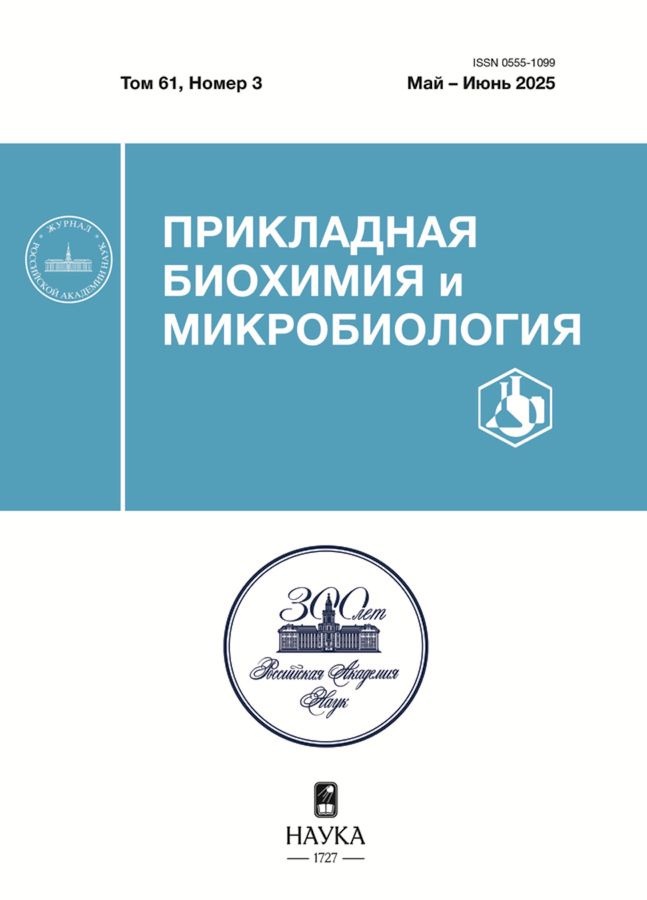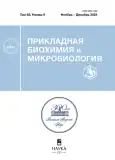Effect of Chitosan-Caffeic Acid Conjugate and Bacillus subtilis Bacteria on the Protective Reactions in PVY-Infected Plants Under Soil Water Deficit
- Authors: Kalatskaja J.N.1, Yarullina L.G.2, Yalouskaya N.A.1, Burkhanova G.F.2, Rybinskaya Е.I.1, Zaikina E.A.2, Ovchinnikov I.A.1, Tsvetkov V.O.3, Herasimovich K.M.1, Cherepanova E.A.2, Ivanov O.A.1, Hileuskaya K.S.4, Nikalaichuk V.V.4
-
Affiliations:
- V.F. Kuprevich Institute of Experimental Botany, the National Academy of Sciences of Belarus
- Institute of Biochemistry and genetics - separate structural subdivision of the Ufa Federal Research Centre of the Russian Academy of Sciences
- Ufa University of Science and Technology
- Institute of Chemistry of New Materials, the National Academy of Sciences of Belarus
- Issue: Vol 60, No 6 (2024)
- Pages: 632-644
- Section: Articles
- URL: https://modernonco.orscience.ru/0555-1099/article/view/681120
- DOI: https://doi.org/10.31857/S0555109924060074
- EDN: https://elibrary.ru/QFLPNI
- ID: 681120
Cite item
Abstract
The effect of chitosan-caffeic acid (Ch-CA) conjugate separately and in combination with a mixture of Bacillus subtilis 47 on the plant defense against PVY under optimal hydration and water deficit in soil was evaluated. The treatments of Ch-CA and Ch-CA+B. subtilis 47 on healthy potato plants under optimal soil moisture conditions demonstrated the accumulation of proline and phenolic compounds, as well as the activation of PPO, which collectively led to an increase in the nonspecific plant defenses. The application of Ch-CA resulted in a reduction of PVY infection in potato plants grown under both optimal and soil moisture-deficient conditions and led to an increase the potato mini-tuber’s mass. The combination of B. subtilis 47 and Ch-CA proved effective in reducing the infection level exclusively under conditions of soil water deficit. It has been demonstrated that the primary factor influencing the development of resistance in potato plants to PVY under moisture-limiting conditions is associated with an elevated peroxidase activity and alterations in antioxidant activity within plant tissues.
Full Text
About the authors
J. N. Kalatskaja
V.F. Kuprevich Institute of Experimental Botany, the National Academy of Sciences of Belarus
Author for correspondence.
Email: kalatskayaj@mail.ru
Belarus, Minsk, 220072
L. G. Yarullina
Institute of Biochemistry and genetics - separate structural subdivision of the Ufa Federal Research Centre of the Russian Academy of Sciences
Email: kalatskayaj@mail.ru
Russian Federation, Ufa, 450054
N. A. Yalouskaya
V.F. Kuprevich Institute of Experimental Botany, the National Academy of Sciences of Belarus
Email: kalatskayaj@mail.ru
Belarus, Minsk, 220072
G. F. Burkhanova
Institute of Biochemistry and genetics - separate structural subdivision of the Ufa Federal Research Centre of the Russian Academy of Sciences
Email: kalatskayaj@mail.ru
Russian Federation, Ufa, 450054
Е. I. Rybinskaya
V.F. Kuprevich Institute of Experimental Botany, the National Academy of Sciences of Belarus
Email: kalatskayaj@mail.ru
Belarus, Minsk, 220072
E. A. Zaikina
Institute of Biochemistry and genetics - separate structural subdivision of the Ufa Federal Research Centre of the Russian Academy of Sciences
Email: kalatskayaj@mail.ru
Russian Federation, Ufa, 450054
I. A. Ovchinnikov
V.F. Kuprevich Institute of Experimental Botany, the National Academy of Sciences of Belarus
Email: kalatskayaj@mail.ru
Belarus, Minsk, 220072
V. O. Tsvetkov
Ufa University of Science and Technology
Email: kalatskayaj@mail.ru
Russian Federation, Ufa, 450076
K. M. Herasimovich
V.F. Kuprevich Institute of Experimental Botany, the National Academy of Sciences of Belarus
Email: kalatskayaj@mail.ru
Belarus, Minsk, 220072
E. A. Cherepanova
Institute of Biochemistry and genetics - separate structural subdivision of the Ufa Federal Research Centre of the Russian Academy of Sciences
Email: kalatskayaj@mail.ru
Russian Federation, Ufa, 450054
O. A. Ivanov
V.F. Kuprevich Institute of Experimental Botany, the National Academy of Sciences of Belarus
Email: kalatskayaj@mail.ru
Belarus, Minsk, 220072
K. S. Hileuskaya
Institute of Chemistry of New Materials, the National Academy of Sciences of Belarus
Email: kalatskayaj@mail.ru
Belarus, Minsk, 220141
V. V. Nikalaichuk
Institute of Chemistry of New Materials, the National Academy of Sciences of Belarus
Email: kalatskayaj@mail.ru
Belarus, Minsk, 220141
References
- Saeed Q., Xiukang W., Haider F.U., Kučerik J., Mumtaz M.Z., Holatko J., et al. // Int. J. Mol. Sci. 2021. V. 22. P. 10529. https://doi.org/10.3390/ ijms221910529
- Vilvert E., Stridh L., Andersson B., Olson Å., Aldén L., Berlin A. // Environmental Evidence. 2022. V. 11. № 6. P. 1–8. https://doi.org/10.1186/s13750-022-00259-x
- Ramegowda V., Senthil-Kumar M. // J. Plant Physiol. 2015. V. 176. P. 47–54. https://doi.org/10.1016/j.jplph.2014.11.008
- Zhang H., Sonnewald U. // The Plant Journal. 2017. V. 90. P. 839–855. https://doi.org/10.1111/tpj.13557
- Hamooh B.T., Sattar F.A., Wellman G., Mousa M.A.A. // Plants. 2021. V. 10. P. 98. https://doi.org/10.3390/plants10010098
- Rubio L., Galipienso L., Ferriol I. // Front. Plant Sci. 2020. V. 11. P. 1092. https://doi.org/doi: 10.3389/fpls.2020.01092
- Jones R.A. // Plants. 2021. V. 10. P. 233. https://doi.org/10.3390/plants10020233
- Riseh R.S., Hassanisaadi M., Vatankhah M., Babaki S.A., Barka E.A. // Int. J. Biol. Macromol. 2022. V. 220 P. 998–1009. https://doi.org/10.1016/j.ijbiomac.2022.08.109
- Shah A., Nazari M., Antar M., Msimbira L.A., Naamala J., Lyu D., et al. // Front. Sustain. Food Syst. 2021. V. 5. P. 667546. https://doi.org/10.3389/fsufs.2021.667546
- Vurukonda S.S.K.P., Vardharajula S., Shrivastava M., SkZ A. // Microbiological Research. 2016. V. 184. P. 13–24. https://doi.org/10.1016/j.micres.2015.12.003
- Maksimov I.V, Abizgil’dina R.R., Pusenkova L.I. // Appl. Biochem. Microbiol. 2011. V 47. № 4 P. 333–345. https://doi.org/10.1134/S0003683811040090
- Miljaković D., Marinković J., Balešević-Tubić S. // Microorganisms. 2020. V. 8. № 7. P. 1037. https://doi.org/10.3390/microorganisms8071037
- Yarullina L.G., Kalatskaja J.N., Cherepanova E.A., Yalouskaya N.A., Tsvetkov V.O., Ovchinnikov I.A., et al. // Appl. Biochem. Microbiol. 2023. V. 59. № 5. P. 549–560. https://doi.org/10.1134/s0003683823050186
- Maksimov I.V., Singh B.P., Cherepanova E.A., Burkhanova G.F., Khairullin R.M. // Appl. Biochem. Microbiol. 2020. V. 56. № 1. P. 15–28. https://doi.org/10.1134/s0003683820010135
- Veselova S.V., Sorokan A.V., Burkhanova G.F., Rumyantsev S.D., Cherepanova E.A., Alekseev V.Y., et al. // Biomolecules. 2022. V. 12. P. 288. https://doi.org/doi: 10.3390/biom12020288
- Amine R., Tarek C., Hassane E., Noureddine E.H., Khadija O. // Molecules. 2021. V. 26. № 4. P. 1117. https://doi.org/10.3390/molecules26041117
- Chirkov S.N. // Appl. Biochem. Microbiol. 2002. V. 38. № 1. P. 1–8. https://doi.org/10.1023/A:1013206517442
- He X., Xing R., Liu S., Qin Y., Li K., Yu H., Li P. // Drug and Chemical Toxicology. 2019. V. 44. № 4. P. 335–340.
- Novikova I.I., Popova E.V., Krasnobaeva I.L., Kovalenko N.M. // Sel’skokhozyaistvennaya Biologiya (Agricultural Biology). 2021. V. 56. P. 511–522.
- Yarullina L.G., Cherepanova E.A., Burkhanova G.F., Sorokan A.V., Zaikina E.A., Tsvetkov V.O., et al. // Microorganisms. 2023. V. 11. № 8. P. 1993. https://doi.org/10.3390/microorganisms11081993
- Dutta J., Tripathi S., Dutta P.K. // Food Science and Technology International. 2012. V.18. №1. P.3–34. https://doi.org/ doi: 10.1177/1082013211399195
- Kumar S., Abedin M.M., Singh A.K., Das S. // Plant Phenolics in Sustainable Agriculture. 2020. V. 1. P. 517–532. https://doi.org/10.1007/978-981-15-4890-1_22
- İlyasoğlu H., Guo Z. // Food Bioscience. 2019. V. 29. P. 118–125. https://doi.org/10.1016/j.fbio.2019.04.007
- Nedved E.L., Kalatskaja J.N., Ovchinnikov I.A., Rybinskaya E.I., Kraskouski A.N., Nikalaichuk V.V., et al. // Appl. Biochem. Microbiol. 2022. V. 58. № 1. P. 69–76. https://doi.org/10.1134/s0003683822010069
- Nikalaichuk V., Hileuskaya K., Kraskouski A., Kulikouskaya V., Nedved H., Kalatskaja J., et al. // J. Appl. Polym. Sci. 2021. V. 139. № 14. P. 51884. https://doi.org/10.1002/app.51884
- Tenover F.C. // Eds Th. M. Schmidt. Encyclopedia of Microbiology. Academic Press. 2019. P. 166–175. https://doi.org/10.1016/B978-0-12-801238-3.02486-7
- Bindschedler L.V., Minibayeva F., Gardner S.L., Gerrish C., Davies D.R., Bolwell G.P. // New Phytol. 2001. V. 151. P. 185–194.
- Bates L.S., Waldren R.P., Teare J.D. // Plant and Soil. 1973. V. 39. № 1. P. 205–207. https://doi.org/10.1007/BF00018060
- Singleton V.L., Orthofer R., Lamuela-Raventos R.M. // Methods in Enzymology. 1999. V. 299. P. 152–178. https://doi.org/10.1016/S0076-6879(99)99017-1
- Kumar V.B.A., Kishor T.C.M., Murugan K. // Food Chemistry. 2008. V. 110 № 2. P. 328–333. https://doi.org/10.1016/j.foodchem.2008.02.006
- Boyarkin A.N. Determination of Peroxidase Activity. /Ed. A.L. Ermakov, Leningrad: Kolos, 1987. P. 41–43.
- Beyer W.F., Fridovich I. // Anal. Biochem. 1987. V. 161. № 2. P. 559–566. https://doi.org/10.1016/0003-2697(87)90489-1
- Nakano Y. Asada K. // Plant Cell Physiol. 1981. V. 22. № 5. P. 867 – 880. https://doi.org/10.1093/oxfordjournals.pcp.a076232
- Aono M., Kubo A., Saji H. // Plant Cell Physiol. 1991. V. 32. № 5. P. 691–697. https://doi.org/10.1093/oxfordjournals.pcp.a078132
- Тарчевский И.А., Егорова А.М. // Прикл. биохимия и микробиология. 2022. T. 58. № 4. С. 315–329. https://doi.org/10.31857/s055510992204016x
- Jia X., Rajib M., Yin H. // Current Pharmaceutical Design. 2020. V. 26. № 29. P. 3508–3521. https://doi.org/10.2174/1381612826666200617165915
- Chakraborty M., Hasanuzzaman M., Rahman M., Khan Md., Bhowmik P., Mahmud N.U., et. al. // Agriculture. 2020. V. 10. № 12. P. 624. https://doi.org/10.3390/agriculture10120624
- Siquet С., Paiva-Martins F., Lima J.L., Reis S., Borges F. // Free Radic. Res. 2006. V. 40. P. 433–442. https://doi.org/10.1080/10715760500540442
- Rivero R.M., Ruiz J.M., Garcia P.C., Lopez-Lcfebre L.R., Sanchez E., Romero L. // Plant Sci. 2001. V. 160. P. 315–321. https://doi.org/10.1016/S0168-9452(00)00395-2
- Yang X., Lan W., Lu M., Wang Z., Xie J. // LWT. 2022. V. 170. P. 114072. https://doi.org/10.1016/j.lwt.2022.114072
- Maslennikova D., Lastochkina O. // Plants. 2021. V.10. № 12. P. 2557. https://doi.org/10.3390/plants10122557
- Smirnoff N., Arnaud D. // New Phytologist. 2019. V. 221. № 3. P. 1197–1214. https://doi.org/10.1111/nph.15488
- Минибаева Ф.В., Гордон Л.Х. // Физиология растений. 2003. Т. 50. № 3. С. 459–464.
- Hernández J.A., Gullner G., Clemente-Moreno M.J., Künstler A., Juhász C., Díaz-Vivancos P., et.al. // Physiol. Mol. Plant Pathol. 2016. V. 94. P. 134–148. https://doi.org/10.1016/j.pmpp.2015.09.001
Supplementary files













